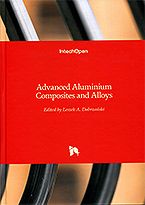Advanced Aluminium Composites and Alloys - Edited by Leszek A. Dobrzański
Advanced Aluminium Composites and Alloys
http://dx.doi.org/10.5772/intechopen.87723
Edited by Leszek A. Dobrzański
Contributors
Jorge Salguero, Moises Batista, Irene Del Sol, Alvaro Gomez-Parra, Uyime Donatus, Mariana Milagre, João Araujo, Caruline Machado, Isolda Costa, Michael Bodunrin, Ayotunde Olayinka, Olamilekan Oloyode, Sunday Aribo, Zygmunt Mikno, Francisco Mata, Issam Hanafi, Halil Ibrahim Kurt, Engin Ergul, Murat Oduncuoglu, Necip Fazil Yilmaz, Xiaoguang Sun, Xiaogang Li, Chaofang Dong, Maria Richert, Rafał Hubicki, Fawzy H. Samuel, Mohamed H. Abdelaziz, Jacobo Hernandez-Sandoval, Agnes Marie Samuel, Herbert Doty, Leszek A. Debrzański
First published in London, United Kingdom, 2021 by IntechOpen
IntechOpen is the global imprint of INTECHOPEN LIMITED, registered in England and Wales,
registration number: 11086078, 5 Princes Gate Court, London, SW7 2QJ, United Kingdom
Printed in Croatia
Additional hard and PDF copies can be obtained from orders@intechopen.com
Print ISBN: 978-1-83880-450-3
Online ISBN: 978-1-83880-451-0
eBook (PDF) ISBN: 978-1-83880-456-5
This book contains a collection of studies by authors from 12 different countries. Despite the asymmetrical number of chapters on each fundamental topic, it means advanced aluminium-based composite materials and alloys of this metal, roughly half in volume was devoted to each of these topics.
The book opens with original study by Leszek Adam Dobrzański on advanced composites based on aluminium alloys and their production processes. Composite materials were manufactured by gas pressure infiltration with liquid aluminium alloys of suitably formed porous skeletons sintered from a mixture of Al203 powder and carbon fibres then are thermally degraded, using halloysite HNTs nanotubes by mechanical milling, consolidation in press and sintering and selective SLS laser sintering of titanium powders. Another group of manufacturing technologies is the mechanical synthesis of a mixture of aluminium alloy powder and HNTs halloysite nanotubes or MWCNTs multi-wall carbon nanotubes, respectively, and subsequent consolidation with plastic deformation. The third group concerns composite surface layers on substrates of aluminium alloys produced by laser feathering of WC/W2C or SiC carbides.
The next chapter in this part of the book, "The Theoretical Overview of the Selected Optimization and Prediction Models Useful in the Design of Aluminium Alloys and Aluminium Matrix Composites," was written by Halil Ibrahim Kurt et al. from Turkey. This chapter presents original research results from their own work and cited from the literature on the theory of artificial neural network (ANN), adaptive neural fuzzy inference systems (ANFIS) and Taguchi method and their applications in engineering design and manufacturing of aluminium alloys and AMC composites.
All other chapters deal with various aspects of aluminium alloys. The chapter titled "Effect of Zr Addition and Aging Treatment on the Tensile Properties of Al-SiCu-Mg Cast Alloys" is prepared by the international team of Jacobo HernandezSandoval et al. from Canada, Mexico, Egypt and the USA. The chapter concerns the tensile strength of analysed materials containing aluminium at room and elevated temperatures. Zirconium forms phases with the participation of Ti, Si and Al, and their coagulation leads to a decrease in strength.
Rafał Hubicki and Maria Richert from Poland have prepared a chapter entitled "The High-Speed 6xxx Aluminium Alloys in Shape Extrusion Industry", where they analyzed alloys used in the automotive and construction industries.
The 9-person team of Uyime Donatus et al. from Brazil, South Africa, USA, UK and Canada wrote the next chapter entitled "Corrosion Resistance of Precipitation Hardened Al Alloys: A Comparison between New Generation Al-Cu-Li and Conventional Alloys". The corrosion resistance of conventional alloys and new alloys of precipitation hardening alloys was compared. The AA6082-T6 alloy became the most resistant to corrosion, while the AA2024-T3 alloy showed the highest density of pitting spots.
The chapter "Machining of Al-Cu and Al-Zn Alloys for Aeronautical Components" by the team of Jorge Salguero et al. from Spain focused on the analysis of the relationship between drilling, milling and turning conditions, quality characteristics and the main wear mechanism during machining as factors influencing performance improvement and micro and macro geometric deviations.
In turn, in the chapter "Analysis of Surface Roughness of EN AW 2024 and EN AW 2030 Alloys after Micromachining" developed by Francisco Mata and Issam Hanafi from Spain and Morocco, the focus was on this technology suitable for the production of very small components in the industry. Very good surface properties can be achieved when turning aluminium alloys with a diameter of not less than 0.05 mm.
Zygmunt Mikno from Poland has prepared a chapter on "Resistance Welding of Aluminium Alloys with an Electromechanical Electrode Force System”, which concerns the operation and depends on the new clamping solution in the welding machine and the optimization of the welding process of aluminium rods. The research consisted of the numerical analysis of two electrode pressure systems, i.e. conventional pneumatic and electromechanical, using the SORPAS software.
Last but not least is the chapter entitled “Applications of Aluminium Alloys in Rail Transportation" and was prepared in China by Xiaoguang Sun et al. This chapter focuses on the latest applications of aluminium alloys, including for the car body, gearbox and steering rack, and analyze key manufacturing techniques such as casting, forming and welding.
This book is a continuation of several books previously published in the last decade by InTech on various theoretical aspects, production, application and research of aluminium, its alloys and composites based on aluminium alloys, edited successively by Tibor Kvackaj (2011), Zaki Ahmad (2011, 2012), Subbarayan Sivasankaran (2017), Kavian Cooke (2020).

